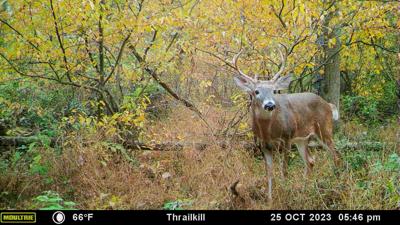Pennsylvania hunters bagged an estimated 430,010 deer during the 2023-24 hunting season, according to the state Game Commission.
That figure includes 171,600 bucks, which are the second-most taken in Pennsylvania in the last 21 years.
The total deer kill last fall was up 2% over the previous season and 4% higher than the three-year average.
In addition to the 171,600 bucks hunters took last fall, they also shot 258,410 antlerless deer. That compares to the 164,190 bucks and 258,770 antlerless deer taken the previous year.
“There’s no denying this a great time to be a Pennsylvania deer hunter,” Game Commission Executive Director Bryan Burhans said. “But best of all, these numbers show that we’re managing deer and their habitat in ways that are sustainable over the long haul. That’s not only best for deer, but for deer hunters, too.”
READ: Can the Pa. Game Commission do a better job of explaining hunting rules? [column]
The 2023-24 buck harvest is the second highest since 2002, when the Game Commission changed the antler restrictions to their current format.
That first year, hunters shot 165,416 bucks, which was the record take under the new antler rules until the 2020-21 season, when the current record 174,780 bucks were tagged.
The 2023-24 buck kill here was up 5% over the previous year, and is 6% higher than the three-year average.
According to Game Commission data, 27% of hunters last fall tagged a buck. That’s 1% higher than the previous year, and significantly higher than the 15% success rate from the 2007-08 season.
The National Deer Association every year crunches harvest data from states where whitetails are hunted across the country and creates a report showing their findings.
The report for the 2023-24 season is still in the draft phase, but in the 2022-23 season report, the association found 40% of hunters in Pennsylvania shot at least one deer that year. That would mean one buck or one antlerless deer.
In Pennsylvania, a hunter can tag only one buck per year, but can add multiple antlerless deer to that buck by acquiring antlerless deer licenses.
The U.S. average for the 2022-23 season was 41% of hunters bagged at least one deer, according to the National Deer Association, ranging from a low of 18% in New Hampshire to a high of 71% in South Carolina.
The bucks Pennsylvania hunters shot last fall were older than they were in past decades.
Before the antler restrictions were changed, most bucks shot here were 1.5 years old.
Last fall, 64% of bucks taken were 2.5 years old and older. The remaining 36% were 1.5.
As for the antlerless deer harvest last fall, 69% of the deer taken were does age 1.5 and older. Another 14% were yearling does and 16% were button bucks – young-of-the-year bucks with no antlers.
About one in four antlerless deer licenses issued last season resulted in a harvested deer.
Breaking down the harvest by weapon type, firearms hunters took 254,710 deer, including 86,260 bucks; bowhunters tagged 154,850 deer, including 83,370 bucks; and muzzleloader hunters shot 20,450 deer, including 1,970 bucks.
Pennsylvania’s top Wildlife Management Unit last season for total deer harvest was WMU 2D, where hunters tagged 33,200 deer.
WMU 2D also was the top unit for total buck harvest, with 11,800, and for the antlerless harvest, with 21,400.
Both numbers actually were down for that unit from the previous season.
READ: Even seasoned hunters not clear on some hunting rules [column]
WMU 5B, which covers nearly all of Lancaster County, accounted for 9,700 bucks and 14,300 antlerless deer. Both totals were down from the previous season.
Hunters in WMU 5C, which covers a tiny sliver of Lancaster County in the northeast, as well as parts of several counties to the east, shot 9,100 bucks last season – which was an increase – and 13,100 antlerless deer – which was a decrease.
You probably notice all of these harvest numbers end in 0, which seems pretty tidy.
They are estimates by the Game Commission, rather than actual figures.
The agency uses an industry-approved calculation to come up with its annual estimates, which agency biologists present with a fair degree of confidence.
Many hunters doubt the numbers every year, professing as much on social media.
“Really don’t believe their numbers,” one hunter wrote on a Facebook page dedicated to Pennsylvania hunting.
“Fake news,” another replied.
But hunters themselves are largely to blame for the agency having to make such calculations.
In Pennsylvania, hunters are required by law to report to the Game Commission every deer they kill. Hunters can do so online, by mail or by phone.
And the online system is ridiculously easy to use. You just click a few boxes and it’s done.
Despite the ease of reporting, only about one third of successful hunters actually report their kills.
Of the 430,010 deer estimated to have been taken last year, about 134,000 were reported to the Game Commission.
As part of its harvest estimation process, the Game Commission has employees physically inspect deer at processing facilities.
Last season, 31 teams of agency workers visited more than 400 processors, where they examined more than 24,000 deer.
Using tag information, those employees then check to see how many of the inspected deer get reported.
The disparity is factored into the calculation to come up with a harvest estimate.
As an oversimplified example, if biologists check 100 deer, and find only 33 were reported, they can add 67 to every 33 deer for which they actually received reports to come up with a total kill estimate.
That wouldn’t be necessary, though, if every kill was reported by hunters.
“The deer program is designed to account for less than 100-percent reporting rates,” said agency spokesman Travis Lau.
“The large quantities of data collected by PGC staff allow for precise harvest estimates with current reporting rates.
“If all hunters reported, we could rely on a simple count of harvest reports.”
READ: Is full Sunday hunting about to become a reality in Pennsylvania? [column]
In a 2020 survey by the Game Commission, 79% of hunters who responded told the agency the reporting methods are “easy and convenient,” Lau said.
And 80% said it’s a hunter’s “ethical responsibility to report” their kills, he said.
Yet only about a third actually do it.
The fine for failure to report a kill is $25, plus court costs.
When asked if the Game Commission prosecutes those hunters whose deer they check and then verify those deer were not reported, Lau said, “Generally not.”
There are states where a hunter can lose the right to buy a license the next year if they fail to report a kill the previous year.
Lau said the Board of Game Commissioners several years ago talked about taking this approach to try to force better reporting.
“But in the end, I think they saw far more drawbacks than benefits, especially when the present system provides reliable data on the reporting rate and harvests,” he said.
“To my knowledge the issue hasn’t been further explored since.”


 P.J. REILLY | Staff Writer
P.J. REILLY | Staff Writer

 AD CRABLE | Outdoors Columnist
AD CRABLE | Outdoors Columnist